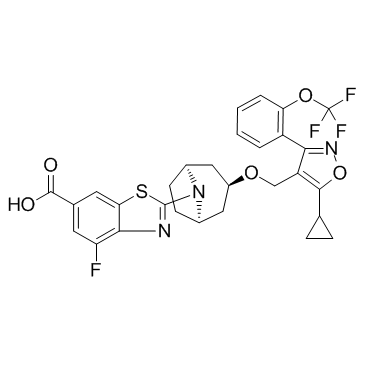| Description |
Tropifexor is a novel and highly potent agonist of FXR with an EC50 of 0.2 nM.
|
| Related Catalog |
|
| Target |
EC50: 0.2 nM (FXR)
|
| In Vitro |
Tropifexor (compound 1) is a novel and highly potent agonist of FXR with an EC50 of 0.2 nM. Robust induction of both BSEP and SHP genes is observed in primary cells by Tropifexor in a concentration-dependent manner. BSEP induction above vehicle (DMSO) control is observed at concentrations as low as 1 nM, while strong induction of SHP (15-fold above vehicle) is observed at 10 nM and modest induction of SHP at 1 nM (3-fold)[1].
|
| In Vivo |
Tropifexor (compound 1) demonstrates highly potent induction of SHP and FGF15 in the ileum as doses as low as 0.1 mg/kg. In the liver, robust induction of SHP is observed at 0.01 mg/kg of Tropifexor with maximal levels of gene induction achieved at 0.3 mg/kg. Expression of CYP8B1 mRNA following 14 day treatment with Tropifexor is already apparent at the lowest dose (0.003 mg/kg), and CYP8B1 gene expression is fully repressed at doses above 0.03 mg/kg. Treatment of rats with Tropifexor exhibits a clear dose-dependent increase in plasma FGF15 protein, with maximal levels of FGF15 detected at 7 h postdose.Treatment with Tropifexor for 14 days produces a robust dose-dependent reduction in serum triglycerides and reaches a maximal response with a 0.3 mg/kg dose, resulting in a decrease of triglyceride levels to approximately 79% below the vehicle control group[1].
|
| Cell Assay |
Primary rat hepatocytes are plated in 24 well plates and incubated with a 5 point dose response of Tropifexor (compound 1) for 24 hours. RNA is harvested from the cells using the RNeasy 96 kit. Quantitative PCR is performed. The fold change of the transcript over no stimulation is calculated using the ΔΔCt method, with DMSO (vehicle control) being no stimulation[1].
|
| Animal Admin |
Adult male wild-type Sprague-Dawley rats are used in this study. All animals are fasted for 3 hours before oral dosing with Tropifexor (compound 1) or with vehicle. Tropifexor is administered orally using a range of four doses (0.03, 0.1, 0.3, and 1.0 mg/kg) and compare directly to the vehicle control group (vehicle: 0.5% methylcellulose, 0.5% Tween 80, 99% water, suspension). Animals are sacrificed seven hours after dosing using CO2, liver, ileum and whole blood (in heparinized tubes) samples are collected for analysis[1].
|
| References |
[1]. Tully DC, et al. Discovery of Tropifexor (LJN452), a Highly Potent Non-bile Acid FXR Agonist for the Treatment of Cholestatic Liver Diseases and Nonalcoholic Steatohepatitis (NASH). J Med Chem. 2017 Dec 8.
|

